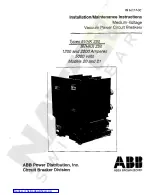
IB
6.1.12.1-1C
1
0
ABB
current signal for fault monitoring. Systems with
communications ability also offer voltage, current,
and power imbalance information.
MPS (Discontinued)
The first of the microelectronic systems, protection
settings were made with switches on the face of the
device. Combinations of long-time, short-time,
instantaneous, and ground trip events were specific
to each device type.
MPS-C (Discontinued)
The MPS-C incorporated a communications interface
with the MPS device. A Network Interface Module is
needed to communicate with the trip device. Like the
MPS trip system, permutations of long-time, short-
time, instantaneous, and ground trip events were
specific to each device type.
MPSC-2000
The MPSC-2000 combined all tripping elements in
one device. Instantaneous or short-time (not both
together), ground, and I
2
t elements are defeatable to
obtain desired coordination. Instead of mechanical
switches, the MPSC-2000 utilizes a LCD for device
interface. Menus allow the user to view real-time
metering information, review protection settings,
modify protection settings with password
authorization, and review operational history. Fault
event history and device settings are recorded in
non-volatile EPROM memory.
MPS-C and MPSC-2000 units can be tested with the
BTSB (Bench-top Trip Simulator for Breakers) both
on and off the breaker. Tested on the breaker, the
BTSB can also operate the magnetic latch as part of
the fault simulation. When testing the MPS-C, the
BTSB interactively guides the user through the test
sequence. When testing the MPSC-2000, the BTSB
runs all tests unassisted and restores the original
settings after test. Results are stored in non-volatile
memory and may be reviewed on-screen or sent to a
printer. The test set also has a port for downloading
future software upgrades.
Undervoltage Trip Device (Optional)
The undervoltage trip device automatically trips the
circuit breaker when the supplied voltage decreases
to between 30% and 60% of the rated voltage. The
device resets when the supplied voltage restores to
80% of its nominal value. This device can be
furnished either for instantaneous trip operation or
with an adjustable time delay, actuating between 1.5
to 15 seconds.
The device coils normally operate continuously to
keep the device armature picked-up. Following
undervoltage drop-out, the breaker remains trip-free
until voltage is restored and the device picks-up
again. Undervoltage devices normally open a
breaker through tripper bar actuation, but may be
configured (non-standard) to trip the latch directly.
Refer to Table A3 of Appendix A for device
characteristics.




































